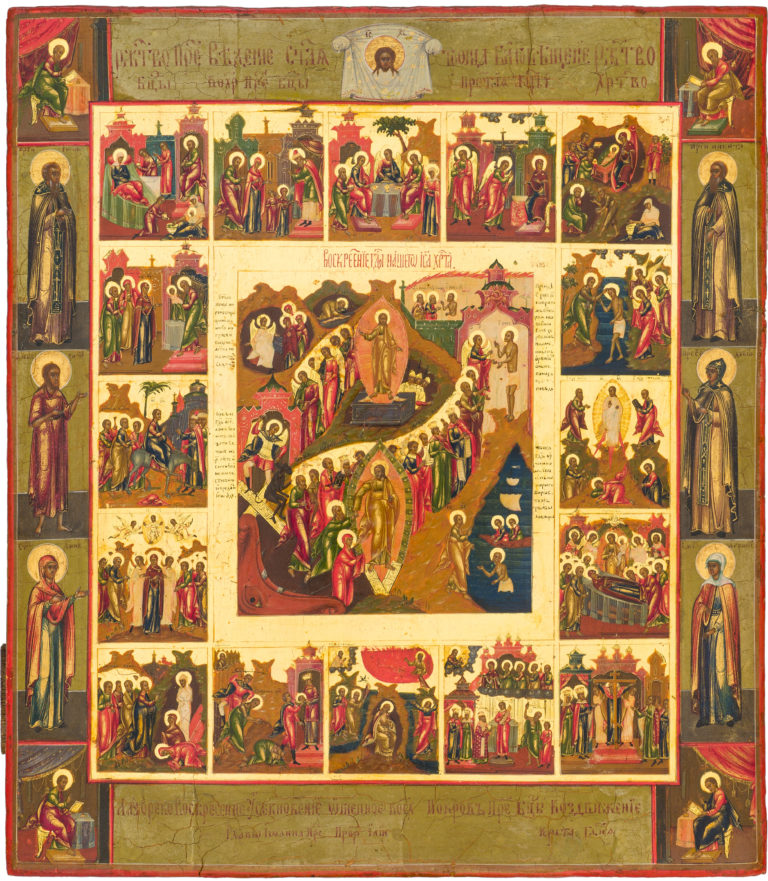The Resurrection—the Descent into Hell, with Church Feasts in 16 Border Scenes, the Holy Mandylion, and Selected Saints
Antique Russian icon. Around the middle of the 19th century. Palekh (?)
Size: 36 х 30.5 х 2.3 cm
Wood (two panels), two incut profiled support boards, a shallow incut centerpiece, underlying layer of gesso not visible, gesso, tempera.
Author’s paintwork is in an overall good state. Slight chafing.
Contact us

The Resurrection—the Descent into Hell, with Church Feasts in 16 Border Scenes, the Holy Mandylion, and Selected Saints
Diagram of the border scenes:
- The Nativity of the Mother of God;
- The Entrance of the Mother of God into the Temple;
- The Old Testament Trinity;
- The Annunciation;
- The Nativity of Christ;
- Candlemas (The Meeting of Christ in the Temple);
- The Theophany (The Baptism of Christ);
- The Entrance intro Jerusalem;
- The Transfiguration;
- The Ascension;
- The Dormition of the Mother of God;
- The Raising of Lazarus;
- The Beheading of John the Baptist;
- The Fiery Ascent of the Prophet Elias;
- The Pokrov (Feast of the Protective veil of the Mother of God);
- The Elevation of the Holy Cross;
- The Holy Mandylion;
- The Evangelist John the Theologian;
- The Evangelist Matthew;
- The Evangelist Mark;
- The Evangelist Luke;
- Saint John of Rylsk (?);
- Saint Niketas of Kostroma;
- Saint Alexius the Man of God;
- Saint Eudokia;
- Saint Anna;
- Saint Agrippina.
Since ancient times, the Resurrection of Christ was among the most popular subjects in Christian religious icon art. The Synodal Period left many examples of these hand-painted icons of Jesus Christ. One of their more common variations is the highly developed, complex composition which includes many additional scenes to the Resurrection. The upper part of the composition usually bears the Resurrection image. In the given antique Russian icon, it is the “Rising from the Tomb” variation: Christ rises from His Tomb, dressed in shining robes, while the guard remains fast asleep. The Angels march from the site of the Tomb to the pits of Hell, where we see the Archangel Michael smiting down Satan. Another thematic center of this Orthodox icon is the Harrowing of Hades scene, where we see Christ leading Adam and Eve, along with all those saved from the Pit of Hell, to the Gate of the Kingdom of Heaven. The Resurrection narrative is traditionally supplemented by other scenes: in the topmost left corner – the Apostle Peter at the Empty Tomb and the Angel, who appeared to the myrrh-bearing women; in the lower right – the Revelation of Christ to the Apostles on the Sea of Galilee.
The border scenes of the antique icon centerpiece bear the depictions of the Twelve Great and Minor Feasts of the Church. The selection of these scenes indicates close ties to the Palekh school of religious icon painting: in the upper tier, we see the traditional depiction of the Old Testament Trinity, and in the lower tier – the Fiery Ascent of the Prophet Elias and the Elevation of the Holy Cross, feasts in honor of which two of Palekh’s churches were consecrated. This hand-painted icon is supplemented by the images of the commissioner’s heavenly patrons that form a family’s pantheon: Saint John of Rylsk (?), Saint Niketas of Kostroma, Saint Alexius – the Man of God, Saint Eudokia, Saint Anna, Saint Agrippina the Martyr. Quite a rare element for this type of Russian icon paintings is the Holy Mandylion placed in the topmost tier. It might possibly indicate that the commissioner belonged to the Priestless strain of Old Believers, who decorated painted or carved Crucifixions with the Holy Mandylion.
Stylistic traits of the given antique Russian icon include the balanced proportions, the elongated, delicate figures, the strong graphic work with the recognizable orientation on Old Russian Art, the emphasized silhouettes, the gold hatching, and the enamel-like paint, which attests to the fact that this beautiful hand-painted icon was created in the middle of the 19th century by a master, who is closely linked to the Palekh tradition of religious icon painting.